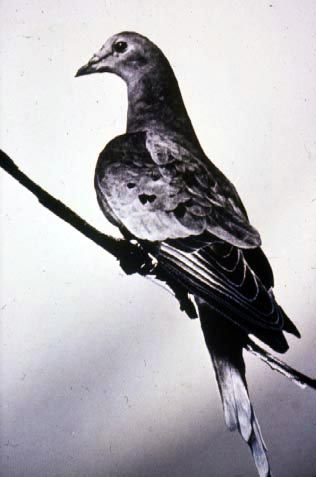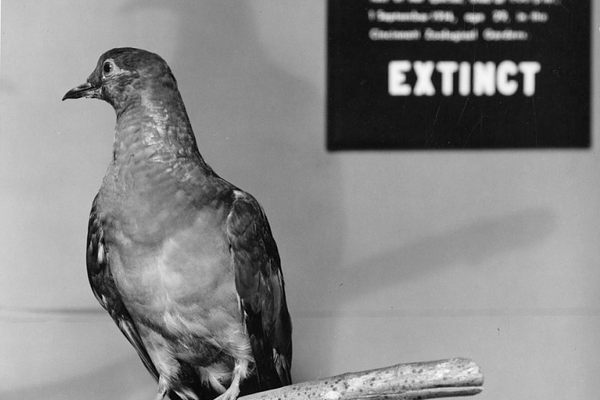Object of Intrigue: Martha, the Last Passenger Pigeon

Martha stuffed, in 1921. (Photo: Public Domain/WikiCommons)
To anyone living in less-than-pristine urban environs, the concept of a celebrity pigeon seems ludicrous—surely the ash-colored flying rats are to be reviled, not exalted. But these people never got a chance to meet Martha.
Martha, a passenger pigeon, died 101 years ago today at her Cincinnati Zoo home. The death of a bird, while a somber moment for your average ornithologist, does not tend to resonate far beyond the bird’s nearest and dearest. But Martha was special. Her death marked the end of not just her lineage but the entire passenger pigeon species, which once flew in great flocks across the United States.
Passenger pigeons, according to the Smithsonian, were once the most common bird in the U.S., numbering in the billions. Hunted for their tasty meat, as well as merely for sport, the birds also experienced habitat loss as human development encroached on the wilderness during the 18th and 19th centuries. But at the time, conservation was not a concern.
In the 1870s, passenger pigeons were still being killed en masse—according to The Smithsonian’s History of America in 101 Objects, a 1878 hunt in Michigan ended in the slaughter of some seven million birds. Baited, trapped, netted, and shot, many of the birds ended up as merchandise in city markets, sold for 50 cents per dozen.
One of the last confirmed sightings of a passenger pigeon in the wild took place in Ohio in March, 1900. By this time, the American Ornithologists’ Union was greatly concerned. From 1909 to 1912, the organization offered a $1,500 bounty to anyone who found a nest or colony of the birds. But the damage was done. The only passenger pigeons left were those in captivity—birds like Martha and her same-species companion, George.

Martha in her enclosure in 1914. (Photo: Public Domain/WikiCommons)
Named after Martha Washington, Martha the pigeon was hatched at the Cincinnati Zoo in 1885. Persistent zookeepers encouraged her to mate with George—christened, of course, after the husband of her human namesake—but these attempts at reproduction were futile. In 1910, George died, leaving Martha as the last representative of her once ubiquitous species.
Martha lived to the age of 29, which Audubon calls “ancient by pigeon standards“–most pigeons are lucky to make it past the age of 15. During her final years, says Joel Greenberg, author of A Feathered River Across the Sky: The Passenger Pigeon’s Flight to Extinction, Martha became less inclined to flutter or move far from her perch. She nonetheless received a steady stream of visitors, who, thanks to a sign posted on her aviary, knew that they were looking at the last living member of a doomed species. Some of these gawkers, according to Greenberg, “would throw sand at her to prompt her to move.”
When Martha died on September 1, 1914, her body was encased in 300 pounds of ice so it could endure the three-day train ride from Cincinnati to Washington, D.C. There, at the National Museum of Natural History, she was photographed, skinned, and mounted with an appropriate level of solemnity. R. W. Shufeldt, an ornithologist tasked with preparing Martha’s body for museum preservation, chose not to fully dissect the heart, writing at the time that he preferred to “preserve it in its entirety—perhaps somewhat influenced by sentimental reasons, as the heart of the last ‘Blue Pigeon’ that the world will ever see alive.”

Martha in a display case in the National Museum of Natural History, 2015. (Photo: Ph0705/WikiCommons CC BY-SA 4.0)
Around the centenary of Martha’s death, a campaign emerged to resurrect the passenger pigeon via DNA samples from preserved specimens held in museum collections in the United States and Canada. In 2013, the Long Now Foundation announced The Great Passenger Pigeon Comeback, a “de-extinction” project aimed at reviving the species. Using the genomes of the rock pigeon and the band-tailed pigeon as a reference, project scientists aim to assemble a complete passenger pigeon genome and transfer it into the germ cells of band-tailed pigeons in order to generate live passenger pigeons. The target date for the passenger pigeons’ triumphant return is 2022.
That plan may seem straightforward, but de-extinction projects come with technical, ethical, and environmental concerns. Regardless of whether the Great Passenger Pigeon Comeback stays on schedule, we will be living in a passenger pigeon-less world for at least the next eight years. During that time, you are welcome to visit Martha, who still stands sentinel on a branch at the National Museum of Natural History in Washington D.C.
























Follow us on Twitter to get the latest on the world's hidden wonders.
Like us on Facebook to get the latest on the world's hidden wonders.
Follow us on Twitter Like us on Facebook